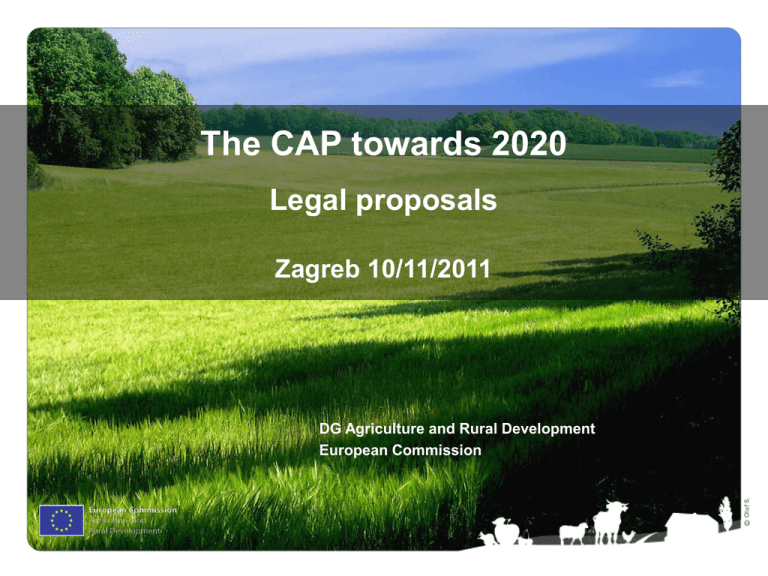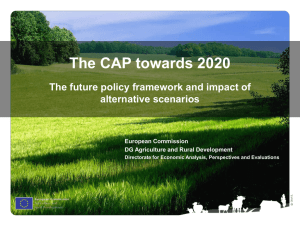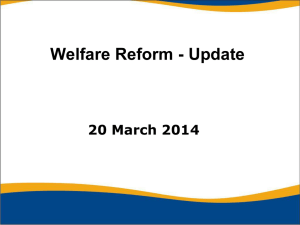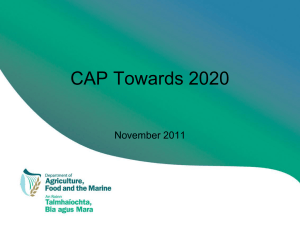Commission Communication `The CAP towards 2020`
advertisement

The CAP towards 2020 Legal proposals Zagreb 10/11/2011 Ⓒ Olof S. DG Agriculture and Rural Development European Commission Outline 1. Process of the CAP reform 2. Policy challenges and objectives 3. CAP proposals in detail 4. What’s next? 2 Where are we with the CAP reform process? 12 April – 11 June 2010 19-20 July 2010 18 November 2010 23 November 2010 – 25 January 2011 29 June 2011 12 October 2011 Public debate (EU citizens and organisations) Public conference Commission Communication ‘The CAP towards 2020’ Consultation on Impact assessment (stakeholders) Commission proposals on the EU budget 2014-2020 Commission legal proposals on the CAP The legal proposals are accompanied by an impact assessment that evaluates alternative scenarios for the evolution of the policy on the basis of extensive quantitative and qualitative analysis Debate in the European Parliament and the Council 2011-2013 Approval of Regulations and implementing acts 3 How will the CAP be financed? • Commission proposals on Multi-Annual Financial Framework for 20142020 to maintain CAP spending at 2013 levels in nominal terms in billion EUR Current prices - Pillar I - Direct payments and market-related expenditure 317.2 - Pillar II - Rural development 101.2 Total Pillar I and II 418.4 - Food safety 2.5 - Most deprived persons 2.8 - Reserve for crises in the agricultural sector 3.9 - European Globalisation Fund - Research and innovation on food security, the bio-economy and sustainable agriculture Total additional amounts Total proposed amounts for the period 2014-2020 Up to 2.8 5.1 Up to 17.1 Up to 435.5 Source: Commission Communication ‘A budget for Europe 2020’ – COM(2011) 500 final, part II. 4 The path of CAP expenditure 1980-2020 (in current prices) 70 EU-10 EU-12 EU-15 EU-25 EU-27 60 40 30 20 10 Export subsidies Other market measures Coupled direct payments Market-related expenditure Direct payments Rural development 2020 2019 2018 2017 2016 2015 2014 2013 2012 2011 2010 2009 2008 2007 2006 2005 2004 2003 2002 2001 2000 1999 1998 1997 1996 1995 1994 1993 1992 1991 1990 1989 1988 1987 1986 1985 1984 1983 1982 1981 0 1980 in billion € - current prices 50 Decoupled direct payments Source: DG Agriculture and Rural Development Notes: 2011 = Budget; 2012 = Draft Budget; 2013 = EAGF subceiling for direct payments and market-related expenditure + pillar 2 in commitments. Rural development for 2013 includes UK voluntary modulation and Article 136 “unspent amounts”. As these cease to exist end 5 2013, the corresponding amounts are put back to direct aids as from 2014. Outline 1. Process of the CAP reform 2. Policy challenges and objectives 3. CAP proposals in detail 4. What’s next? 6 What are the challenges for agriculture… Commission Communication ‘The CAP towards 2020’ Challenges • Economic • Environmental Territorial • Economic challenges – Food security – Price variability – Economic crisis Environmental challenges – GHG emissions – Soil depletion – Water/air quality – Habitats and biodiversity Territorial challenges – Vitality of rural areas – Diversity of EU agriculture 7 Recent trends in commodity prices (World Bank nominal price indices, 2000=100) 600 525 Fertilisers + 163 % Energy + 223 % 450 375 300 Agriculture + 50 % 225 150 75 2010 2009 2008 2007 2006 2005 2004 2003 2002 2001 2000 1999 1998 1997 1996 1995 1994 1993 1992 1991 1990 1989 1988 1987 1986 0 Source: World Bank. 8 Climate change – Possible impacts on EU agriculture ▲ Floods risk ▲ Hotter and drier summers ▲ Sea levels ▲ Risk crop pests, diseases ▲ Crop, forage yields ▼ Animal health, welfare ▼ Summer rainfall ▲ Winter storms, floods ▲ Length growing season, yields ▲ Suitable farmland ▲ Pests, diseases risks ▲ Winter rainfall, floods ▼ Summer rainfall ▲ Risk drought, water stress ▲ Soil erosion risk ▲ Yields, range of crops ▼ Water availability ▲ Risk drought, heat spells ▲ Risk soil erosion ▼ Growing season, crop yields ▼ Optimal crop areas Source: DG Agriculture and Rural Development, based on EEA reports, JRC and MS academic studies 9 … and how will the CAP address them? Commission Communication ‘The CAP towards 2020’ Challenges Policy objectives Legal proposals Reform objectives Europe 2020 Economic Environmental Territorial Viable food production Sustainable management of natural resources and climate action Balanced territorial development Enhanced competitiveness Improved sustainability Greater effectiveness Simplification 10 What CAP instruments to meet the reform objectives? Enhanced competitiveness Improved sustainability • Improved economic tools to address market developments Greater effectiveness • New ‘green’ payment in Pillar I • Redesign of direct payments • Crises reserve / Risk management toolkit • Enhanced cross compliance for climate change • Common strategic framework for EU funds • Improved position of farmers in the food supply chain • Two environmental priorities for rural development • Research, innovation and knowledge transfer and an improved Farm Advisory System • Research, innovation and knowledge transfer and an improved Farm Advisory System Pillar I • Redistribution of direct payments across and within Member States • Allocation of rural development envelopes • Simplification of the policy Pillar II Flexibility 11 Outline 1. Process of the CAP reform 2. Policy challenges and objectives 3. CAP proposals in detail 4. What’s next? 12 New design of direct payments (1) • In 2014, EU farmers would have access to: Compulsory schemes (all MS): (+) Voluntary schemes (MS choice): – Basic payment scheme – Coupled support – ‘Green’ payment* – Support in natural constraint areas – Young farmers scheme All payments subject to cross compliance All farmers will have access to the Farm Advisory System OR A simplified scheme for small farmers (compulsory for MS, choice for farmer) * Payment for agricultural practices beneficial to climate change and the environment 13 New design of direct payments (2) Degressivity and Capping (all layers except Green Payment) Cross compliance • Streamlined – Climate change Coupled support • Wide range of sectors • Up to 5% or 10% of DP envelope, to be decided by MS Natural constraint support • For areas with natural constraints • Up to 5% of the DP envelope Small Farmer Scheme • Simplification of claims and controls Young Farmer Scheme • Up to 2% of DP envelope • < 40 years • For 5 years • Commencing activity • Lump sum payment to be determined by MS under conditions ‘Green’ Payment • Crop diversification • Permanent grassland • Ecological focus area • Entrance in 2014 • 30% of the DP envelope • Up to 10% of the DP envelope Basic Payment Scheme • National or regional flat rate per eligible hectare • Regions and criteria to be chosen by MS • New entitlements in 2014 • Definition of agricultural activity • Definition of active farmer OR 14 Redistribution of DP - Closing one third of the gap EUR/ha between current level and 90% of EU average by 2020 800 700 600 500 * Calculated on the basis of all direct aids on the basis of Council Regulation (EC) No 73/2009, after modulation and phasing-in, except POSEI/SAI and cotton and potentially eligible area 2009 400 300 200 DP new distribution (EUR/ha)** EU-27 average (EUR/ha) Latvia Estonia Lithuania Romania Portugal Slovakia Poland United Kingdom Spain Bulgaria Sweden Finland Czech Republic Hungary Austria EU-27 Ireland Luxembourg France Germany Slovenia Denmark Cyprus Greece Italy Belgium Netherlands 0 Malta 100 DP status-quo (EUR/ha)* 90% of EU-27 average (EUR/ha) * Calculated on the basis of all direct aids on the basis of Council Regulation (EC) No 73/2009, after modulation and phasing-in, except POSEI/SAI and cotton and potentially eligible area 2009 ** Calculated on the basis of Annex II to DP proposal for claim year 2019 (budget year 2020) and potentially eligible area (PEA) 2009 Source: European Commission - DG Agriculture and Rural Development 15 Improved instruments to address market developments (sCMO) Forum for a Better Functioning Food Supply Chain Increased financing for research and innovation Sustainable consumption - School Fruit and Milk Scheme • Increased funding • New measures available for EU co-funding Encouraging common action – better position in the food supply chain • Facilitated recognition of: Producer Organisations (PO), Associations of POs, Interbranch Organisations • More clarity as regards competition rules • Link to Rural Development funds (start-up and co-operation measures) Link to the consumer Common responses to economic and environmental challenges Continued market orientation • End of certain aid schemes (Skimmed Milk Powder, hops and silkworms) • End of production limits (sugar) Enhanced safety-net • Exceptional measures – more flexibility and greater coherence • Public intervention/private storage simplified, more responsive to crises • “Crises reserve” Competitiveness of individual agricultural producers 16 Rural development in a new framework (1) Europe 2020 strategy Common Strategic Framework (CSF) – covering the EAFRD, ESF, Cohesion Fund and EMFF, and reflecting EU2020 through common thematic objectives to be addressed by key actions for each of the funds Partnership Contract – national document outlining the intended use of the funds in the pursuit of EU2020 objectives Rural development policy: EAFRD Other CSF funds (ERDF, ESF, Cohesion Fund the EMFF) Priorities Innovation, Environment and Climate Change as cross-cutting themes Fostering knowledge transfer and Innovation in agriculture, forestry and rural areas Enhancing competitiveness of all types of agriculture and farm viability Promoting food chain organisation and risk management in agriculture Restoring, preserving and enhancing ecosystems dependent on agriculture and forestry Promoting resource efficiency and supporting the shift towards a low carbon and climate resilient economy in agriculture, food and forestry sectors Promoting social inclusion, poverty reduction and economic development in rural areas Rural Development Programme(s) 17 Outline 1. Process of the CAP reform 2. Policy challenges and objectives 3. CAP proposals in detail 4. What’s next? 18 What’s next? The Commission presents a set of proposals designed to make the CAP a more effective policy for a more competitive and sustainable agriculture and vibrant rural areas The discussion is now launched with the other institutions with the aim of having the CAP reform in place as from 1st January 2014 19 For further information • The CAP after 2013 http://ec.europa.eu/agriculture/cap-post-2013/index_en.htm • Commission Communication ‘The CAP towards 2020’ http://ec.europa.eu/agriculture/cap-post-2013/communication/ index_en.htm • Impact assessment http://ec.europa.eu/agriculture/analysis/perspec/cap-2020/index_en.htm • Legal proposals http://ec.europa.eu/agriculture/cap-post-2013/legal-proposals/index_en.htm • Journalists platform https://ag-press.eu 20 Thank you 21







